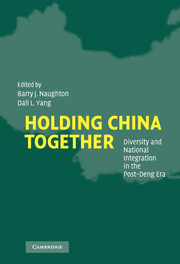Book contents
- Frontmatter
- Contents
- List of Figures and Tables
- List of Contributors
- Acknowledgments
- Holding China Together: Introduction
- PART ONE THE INSTITUTIONS FOR POLITICAL AND ECONOMIC CONTROL: ADAPTATION OF A HIERARCHICAL SYSTEM
- PART TWO CASE STUDIES OF POLICY IMPLEMENTATION
- 5 Policy Consistency in the Midst of the Asian Crisis: Managing the Furloughed and the Farmers in Three Cities
- 6 Population Control and State Coercion in China
- 7 The Political Economy of Industrial Restructuring in China's Coal Industry, 1992–1999
- 8 The Western Development Program
- Index
7 - The Political Economy of Industrial Restructuring in China's Coal Industry, 1992–1999
Published online by Cambridge University Press: 08 December 2009
- Frontmatter
- Contents
- List of Figures and Tables
- List of Contributors
- Acknowledgments
- Holding China Together: Introduction
- PART ONE THE INSTITUTIONS FOR POLITICAL AND ECONOMIC CONTROL: ADAPTATION OF A HIERARCHICAL SYSTEM
- PART TWO CASE STUDIES OF POLICY IMPLEMENTATION
- 5 Policy Consistency in the Midst of the Asian Crisis: Managing the Furloughed and the Farmers in Three Cities
- 6 Population Control and State Coercion in China
- 7 The Political Economy of Industrial Restructuring in China's Coal Industry, 1992–1999
- 8 The Western Development Program
- Index
Summary
After 10 years of reform, China had gradually grown out of the planned economy and, in most sectors, the market had replaced bureaucracies as the main mechanism for coordinating economic transactions. By the beginning of the 1990s, shortages had already become a thing of the past and industrial products flooded markets, manifesting the power of the market economy. Moreover, most markets were populated by a large number of small- and medium-sized firms. With small market shares and low capitalization, these firms were incapable of investing in advanced technologies and developing new products; they had to resort to cutthroat competition at the low end of production. Industrial restructuring was clearly needed if the competitiveness of Chinese industries were to be improved in the long run. With the massive entry of multinational corporations at the beginning of the 1990s, the very survival of many Chinese indigenous industries was called into question and generated heated debates within policy circles. Instead of erecting barriers and warding off international competition, the new central leadership under Jiang Zemin and Zhu Rongji decided to actively intervene in this process and help read just industrial structures in a more rational manner so that domestic firms could meet challenges from the outside. Through economic incentives and administrative coercion, the central government tried to encourage (sometimes force) some inefficient industrial firms to diversify into other businesses and leave market shares to more competitive ones.
- Type
- Chapter
- Information
- Holding China TogetherDiversity and National Integration in the Post-Deng Era, pp. 226 - 252Publisher: Cambridge University PressPrint publication year: 2004
- 2
- Cited by



